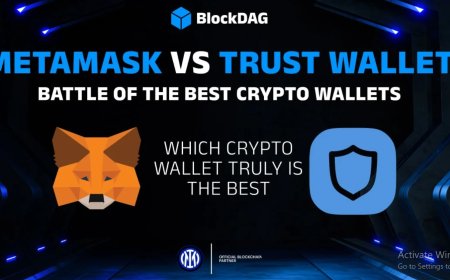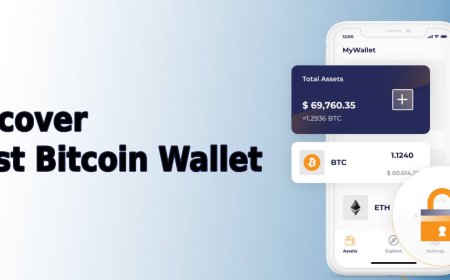What Are the Must-Have Features in Token Design? A Comprehensive Guide for 2025
Discover the essential features every token must have in 2025, from utility and governance to security and tokenomics, in this detailed guide.

As blockchain and decentralized technologies continue to evolve, tokens have become the building blocks of everything from DeFi protocols and NFTs to DAOs, metaverse economies, and Web3 platforms. However, creating a token isn't just about minting digital coins its about designing a robust, functional, and secure token that delivers long-term value and utility.
Effective token design is what distinguishes successful blockchain projects from those that fade into obscurity. It impacts how your token functions, gains trust, maintains value, ensures compliance, and interacts with users and ecosystems. In this comprehensive blog, well explore the must-have features in token development design, their strategic importance, and how to embed them into your crypto project to ensure functionality, growth, and adoption.
What Is Token Design?
Token design refers to the process of architecting the structure, behavior, and rules of a digital token within a blockchain ecosystem. It involves determining how a token is created, how it interacts with smart contracts and users, what utility it provides, and how it circulates within its ecosystem.
Why Token Design Matters
-
Security: Poorly designed tokens are vulnerable to hacks and exploits.
-
Utility: Clear token purpose ensures user engagement and platform functionality.
-
Sustainability: Strong tokenomics prevent inflation and loss of value.
-
Compliance: Regulatory design ensures legitimacy and longevity.
-
Adoption: Well-designed tokens drive trust, community growth, and liquidity.
Types of Tokens
Before designing, its important to determine your token type:
-
Utility Tokens Provide access or features (e.g., BAT, GRT)
-
Security Tokens Represent assets or shares (e.g., tZERO)
-
Governance Tokens Used for protocol voting (e.g., COMP, UNI)
-
Stablecoins Pegged to fiat currencies (e.g., USDC, DAI)
-
NFTs Non-fungible assets representing digital ownership (e.g., CryptoPunks)
-
Reward Tokens For incentivization or staking (e.g., CAKE)
Each type influences design priorities.
Must-Have Features in Token Design
1. Token Utility
Why it matters: A token must serve a purpose within its ecosystem.
Design checklist:
-
Define what the token can do (access, vote, pay, reward).
-
Ensure it connects with core platform functions.
-
Avoid being a valueless or speculative token.
Example: In Axie Infinity, AXS tokens are used for staking, governance, and breeding NFTsmaking the utility clear and valuable.
2.Security and Compliance
Why it matters: Token exploits or compliance violations can destroy projects.
Design checklist:
-
Follow audited smart contract templates (like OpenZeppelin).
-
Include safe math functions to prevent overflow.
-
Integrate blacklist/whitelist functions for regional compliance.
-
Consider RegTech frameworks for security tokens.
Example: Security tokens often embed KYC/AML logic directly into the smart contract.
3.Interoperability
Why it matters: Your token should interact with other chains, apps, and platforms.
Design checklist:
-
Use ERC-20 (Ethereum) or BEP-20 (BNB Chain) standards.
-
Enable bridging with platforms like Polygon, Avalanche, Solana.
-
Consider cross-chain wrappers (e.g., Wormhole, Multichain).
Example: USDC exists as an interoperable stablecoin across multiple chains, increasing its adoption.
4.Token Economics (Tokenomics)
Why it matters: Poorly planned supply or distribution leads to crashes.
Design checklist:
-
Set max supply limits (or inflation logic).
-
Define distribution strategy: team, investors, staking, treasury, liquidity.
-
Include vesting schedules for team/investors.
-
Plan deflationary mechanics (burning, buybacks).
Example: Uniswap's UNI token has a 4-year vesting period for team members, preventing dump scenarios.
5.Minting and Burning Mechanisms
Why it matters: Controls the supply and ensures price stability.
Design checklist:
-
Enable minting for new token creation (e.g., staking rewards).
-
Enable burning for removing tokens from circulation.
-
Automate burning via transaction tax or fee burn.
Example: BNB uses a quarterly burn based on profits, increasing token scarcity.
6.Transferability and Ownership
Why it matters: Token holders should be able to use their assets freelyor in some cases, with control.
Design checklist:
-
Ensure seamless transfer between users.
-
Enable pausable contracts to freeze transfers in emergencies.
-
Add role-based permissions for token ownership and admin rights.
Example: USDT includes admin controls to freeze tokens in illicit wallets.
7.Smart Contract Standards
Why it matters: Ensures compatibility with wallets, exchanges, and dApps.
Design checklist:
-
Follow ERC-20, ERC-721, ERC-1155, or other standards.
-
Use OpenZeppelin or audited libraries for deployment.
-
Ensure proper implementation of approve(), transfer(), transferFrom() functions.
Example: A standard ERC-20 token integrates seamlessly with MetaMask and Uniswap.
8.Upgradeability
Why it matters: Enables future improvements without losing deployed contracts or balances.
Design checklist:
-
Use proxy patterns or upgradable contract frameworks (e.g., OpenZeppelins upgradeable contracts).
-
Implement admin control for authorized upgrades.
-
Document upgrade paths and policies.
Example: Compound Finance uses upgradable contracts to add features and fix bugs over time.
9.Governance Integration
Why it matters: Community-led governance is central to Web3.
Design checklist:
-
Assign voting power based on token holdings.
-
Integrate with governance platforms like Snapshot.
-
Enable proposals, voting, and execution.
Example: MakerDAOs MKR token allows users to vote on changes to the DAI stablecoin system.
10.Transparency and Auditing
Why it matters: Boosts trust and reduces risk.
Design checklist:
-
Open-source your token code.
-
Publish external audit reports.
-
Enable on-chain event logging for all critical actions (e.g., mint, burn, vote).
Example: Most top tokens are audited by CertiK, Hacken, or Trail of Bits and display this prominently.
Additional Features to Consider
-
Reflection Rewards: Redistribute a portion of transactions to holders.
-
Transaction Taxes: Fund liquidity pools, marketing wallets, or burns.
-
Staking Integration: Lock tokens in smart contracts for rewards.
-
Multi-Sig Admin Wallets: Enhance operational security.
-
Time Locks: Prevent sudden or malicious contract changes.
-
Decentralized Identity (DID): For compliance and personalization.
Token Design for Different Use Cases
| Use Case | Token Features |
|---|---|
| DeFi Platform | Staking, liquidity rewards, governance |
| NFT Marketplace | ERC-721/ERC-1155 support, royalty logic |
| DAO | Governance logic, vote delegation |
| GameFi | In-game currency, reward mechanics |
| Metaverse | Interoperable assets, land ownership |
| Stablecoin | Peg mechanism, reserve auditing |
| Security Token | KYC/AML logic, dividend distribution |
Common Mistakes in Token Design
-
No utility: Creating a token that serves no purpose.
-
No supply cap or deflation model: Leading to hyperinflation.
-
Poor distribution strategy: Concentrating tokens with insiders.
-
No audit or buggy code: Leaving the protocol open to exploits.
-
Centralized control: Risking regulatory issues and user distrust.
Best Practices for Token Design
-
Use existing standards and templates (e.g., OpenZeppelin)
-
Design with compliance in mind (e.g., SEC regulations)
-
Integrate token with ecosystem early (wallets, DEXs, staking)
-
Include community in design decisions (via governance)
-
Future-proof with upgradeability and documentation
Tools and Frameworks to Use
Smart Contract Tools:
-
Remix IDE
-
Truffle / Hardhat
-
OpenZeppelin Contracts
-
Brownie (Python)
Testing & Audit:
-
MythX
-
Slither
-
CertiK, Hacken, Quantstamp
Governance & DAO:
-
Aragon
-
Snapshot
-
DAOstack
Analytics & Monitoring:
-
The Graph
-
Dune Analytics
-
Etherscan
Conclusion
Token design is more than just deploying codeits a strategic framework that shapes the success, utility, and trust of your entire crypto ecosystem. By embedding the right featuresfrom tokenomics and security to interoperability and governanceyou not only future-proof your project but also create meaningful value for users, developers, and investors.




























